The Effective Separation of Gallium, Vanadium, and Aluminum from a Simulated Bayer Solution by Resin Exchange
Abstract
:1. Introduction
2. Material and Methods
2.1. Material
2.2. Characterization of the JK Resin
2.3. Adsorption and Desorption Experiment
2.4. Adsorption Isotherm Model
2.5. Adsorption Kinetics Model
3. Results and Discussion
3.1. Screening of Adsorbents
3.2. Adsorption Experiments
3.3. Adsorption Isotherm
3.4. Adsorption Kinetics
3.5. Desorption Study
3.6. Resin Recyclability
3.7. Resin Characterization
3.8. Adsorption Mechanism
4. Conclusions
Author Contributions
Funding
Institutional Review Board Statement
Informed Consent Statement
Data Availability Statement
Conflicts of Interest
References
- Moskalyk, R.R. Gallium: The backbone of the electronics industry. Miner. Eng. 2003, 16, 921–929. [Google Scholar] [CrossRef]
- Illés, I.B.; Kékesi, T. The production of high-purity gallium from waste LEDs by combining sulfuric acid digestion, cation-exchange and electrowinning. J. Environ. Chem. Eng. 2023, 11, 110391. [Google Scholar] [CrossRef]
- Kashif, M.; Halepoto, A.; Memon, A.; Su, Y.; Abduallah, M.; Soomro, M.Y. Gallium oxide impregnated on porous clay heterostructures material for selective catalytic reduction of nitrogen oxide with C3H6. J. Environ. Chem. Eng. 2020, 8, 103943. [Google Scholar] [CrossRef]
- Qin, Z.; Liao, Y.; Wang, Z.; Wang, S.; Song, L.; Ma, K.; Luo, D.; Yue, H. Innovative Amidoxime Nanofiber Membranes for Highly Effective Adsorption of Ga(III) from Waste Bayer Solution. Ind. Eng. Chem. Res. 2023, 62, 11140–11150. [Google Scholar] [CrossRef]
- Frenzel, M.; Mikolajczak, C.; Reuter, M.A.; Gutzmer, J. Quantifying the relative availability of high-tech by-product metals—The cases of gallium, germanium and indium. Resour. Policy 2017, 52, 327–335. [Google Scholar] [CrossRef]
- Gladyshev, S.V.; Akcil, A.; Abdulvaliyev, R.A.; Tastanov, E.A.; Beisembekova, K.O.; Temirova, S.S.; Deveci, H. Recovery of vanadium and gallium from solid waste by-products of Bayer process. Miner. Eng. 2015, 74, 91–98. [Google Scholar] [CrossRef]
- Shivani; Kaur, D.; Ghosh, A.; Kumar, M. A strategic review on gallium oxide based power electronics: Recent progress and future prospects. Mater. Today Commun. 2022, 33, 104244. [Google Scholar] [CrossRef]
- Suganya, R.; Naveenkumar, P.; Balaji, B.; Gayathri, D. Sliding Mode Resonant Controlled Step up Coupled Inductor fed DC-DC converter with Gallium Oxide Semiconductor Material. Mater. Today Proc. 2023, 77, 414–423. [Google Scholar] [CrossRef]
- Chen, W.; Wang, Y.; Chiu, K. The separation and recovery of indium, gallium, and zinc from spent GZO(IGZO) targets. J. Environ. Chem. Eng. 2017, 5, 381–390. [Google Scholar] [CrossRef]
- Zhao, Z.; Yang, Y.; Xiao, Y.; Fan, Y. Recovery of gallium from Bayer liquor: A review. Hydrometallurgy 2012, 125–126, 115–124. [Google Scholar] [CrossRef]
- Hoang, A.S.; Nguyen, H.N.; Quoc Bui, N.; Vu, H.S.; Vo, T.P.; Nguyen, T.V.; Minh Phan, C. Extraction of gallium from Bayer liquor using extractant produced from cashew nutshell liquid. Miner. Eng. 2015, 79, 88–93. [Google Scholar] [CrossRef]
- Zhang, J.; Luo, Z.; Jiang, H.; Jiang, J.; Chen, C.; Zhang, J.; Gui, Z.; Xiao, N. Highly transparent cerium doped gadolinium gallium aluminum garnet ceramic prepared with precursors fabricated by ultrasonic enhanced chemical co-precipitation. Ultrason. Sonochem. 2017, 39, 792–797. [Google Scholar] [CrossRef]
- Lu, F.; Xiao, T.; Lin, J.; Ning, Z.; Long, Q.; Xiao, L.; Huang, F.; Wang, W.; Xiao, Q.; Lan, X.; et al. Resources and extraction of gallium: A review. Hydrometallurgy 2017, 174, 105–115. [Google Scholar] [CrossRef]
- MacNevin, W.M.; Moorhead, E.D. A reversible dropping gallium amalgam electrode. J. Am. Chem. Soc. 1959, 81, 6382–6385. [Google Scholar] [CrossRef]
- Font, O.; Querol, X.; Juan, R.; Casado, R.; Ruiz, C.R.; López-Soler, Á.; Coca, P.; Peña, F.G. Recovery of gallium and vanadium from gasification fly ash. J. Hazard. Mater. 2007, 139, 413–423. [Google Scholar] [CrossRef]
- Qin, Z.; Zhang, G.; Luo, D.; Li, C.; Yue, H.; Liang, B. Separation of titanium from vanadium and iron in leach solutions of vanadium slag by solvent extraction with trioctyl tertiary amine (N235). Hydrometallurgy 2019, 188, 216–221. [Google Scholar] [CrossRef]
- Qin, Z.; Zhang, G.; Xiong, Y.; Luo, D.; Li, C.; Tang, S.; Yue, H.; Liang, B. Recovery of vanadium from leach solutions of vanadium slag using solvent extraction with N235. Hydrometallurgy 2020, 192, 105259. [Google Scholar] [CrossRef]
- Zhang, K.; Qiu, L.; Tao, J.; Zhong, X.; Lin, Z.; Wang, R.; Liu, Z. Recovery of gallium from leach solutions of zinc refinery residues by stepwise solvent extraction with N235 and Cyanex 272. Hydrometallurgy 2021, 205, 105722. [Google Scholar] [CrossRef]
- Liu, F.; Liu, Z.; Li, Y.; Wilson, B.P.; Liu, Z.; Zeng, L.; Lundström, M. Recovery and separation of gallium(III) and germanium(IV) from zinc refinery residues: Part II: Solvent extraction. Hydrometallurgy 2017, 171, 149–156. [Google Scholar] [CrossRef]
- Nusen, S.; Chairuangsri, T.; Zhu, Z.; Cheng, C.Y. Recovery of indium and gallium from synthetic leach solution of zinc refinery residues using synergistic solvent extraction with LIX 63 and Versatic 10 acid. Hydrometallurgy 2016, 160, 137–146. [Google Scholar] [CrossRef]
- Vernon, F. Ion Exchange on LIX 65N and Kelex 100 Impregnated Foams. Sep. Sci. Technol. 2006, 13, 587–595. [Google Scholar] [CrossRef]
- Raiguel, S.; Dehaen, W.; Binnemans, K. Extraction of gallium from simulated Bayer process liquor by Kelex 100 dissolved in ionic liquids. Dalton Trans. 2020, 49, 3532–3544. [Google Scholar] [CrossRef]
- Roosen, J.; Mullens, S.; Binnemans, K. Chemical immobilization of 8-hydroxyquinoline and 8-hydroxyquinaldine on chitosan-silica adsorbent materials for the selective recovery of gallium from Bayer liquor. Hydrometallurgy 2017, 171, 275–284. [Google Scholar] [CrossRef]
- Khalil, M.; Sayed, M.A.; Kotp, Y.H. Gamma radiation-induced synthesis of TiO2 immobilized on polyacrylonitrile nanocomposite for gallium, strontium and rubidium ions separation from aqueous solutions. Radiat. Phys. Chem. 2023, 212, 111085. [Google Scholar] [CrossRef]
- Meng, J.; He, C.; Li, Y.; Zhou, J.; Li, J.; Zheng, C.; Zhao, J.; Fujita, T.; Ning, S.; Wei, Y. Enhanced adsorption and separation of gallium using silica-based P507-TBP/SiO2–P adsorbent from sulfuric acid solution. Microporous Mesoporous Mater. 2021, 314, 110859. [Google Scholar] [CrossRef]
- Raj, P.; Patel, M.; Karamalidis, A.K. Functionalization of cellulose adsorbents with catechol derivatives for the effective separation and recovery of gallium from acidic solutions. Sep. Sci. Technol. 2023, 323, 124396. [Google Scholar] [CrossRef]
- Li, W.; Zhou, C.; Li, C.; Zhu, W.; Shi, J.; Liu, G. Synthesis of UiO-66 series metal–organic framework composites and the adsorption effect on gallium. Chem. Eng. J. 2023, 455, 140881. [Google Scholar] [CrossRef]
- Liu, Z.; Zong, Y.; Li, H.; Jia, D.; Zhao, Z. Selectively recovering scandium from high alkali Bayer red mud without impurities of iron, titanium and gallium. J. Rare Earths 2017, 35, 896–905. [Google Scholar] [CrossRef]
- Qin, Z.; Wang, S.; Fan, L.; Zhou, C.; Wang, C.; Song, L.; Ma, K.; Yue, H. A hydrazine amidoxime crosslinked polyacrylonitrile resin for efficient extraction of gallium from vanadium-containing waste solution. Chem. Eng. Sci. 2023, 282, 119240. [Google Scholar] [CrossRef]
- Kumar, R.; Rauwel, P.; Kriipsalu, M.; Wragg, D.; Rauwel, E. Nanocobalt based (Co@Co(OH)2) sand nanocomposite applied to manganese extraction from contaminated water. J. Environ. Chem. Eng. 2023, 11, 109818. [Google Scholar] [CrossRef]
- Tran, H.N.; Lima, E.C.; Juang, R.-S.; Bollinger, J.-C.; Chao, H. Thermodynamic parameters of liquid–phase adsorption process calculated from different equilibrium constants related to adsorption isotherms: A comparison study. J. Environ. Chem. Eng. 2021, 9, 106674. [Google Scholar] [CrossRef]
- Kou, Z.; Bian, W.; Wang, C. Preparation of novel amidoxime resin and its performance in gallium (III) extraction from Bayer liquor. Chem. Eng. J. Adv. 2022, 11, 100317. [Google Scholar] [CrossRef]
- Lu, S.; Chen, L.; Hamza, M.F.; He, C.; Wang, X.; Wei, Y.; Guibal, E. Amidoxime functionalization of a poly(acrylonitrile)/silica composite for the sorption of Ga(III)—Application to the treatment of Bayer liquor. Chem. Eng. J. 2019, 368, 459–473. [Google Scholar] [CrossRef]
- Wang, D.; Song, J.; Wen, J.; Yuan, Y.; Liu, Z.; Lin, S.; Wang, H.; Wang, H.; Zhao, S.; Zhao, X.; et al. Significantly Enhanced Uranium Extraction from Seawater with Mass Produced Fully Amidoximated Nanofiber Adsorbent. Adv. Energy Mater. 2018, 8, 1802607. [Google Scholar] [CrossRef]
- Wu, M.-B.; Liu, S.; Fei, J.; Ye, H.; Ma, L. Natural cellulose-based microspheres decorated with amidoxime groups for decontamination of radioactive wastewater. Appl. Surf. Sci. 2022, 597, 153659. [Google Scholar] [CrossRef]
- Zhao, Z.; Li, X.; Chai, Y.; Hua, Z.; Xiao, Y.; Yang, Y. Adsorption Performances and Mechanisms of Amidoxime Resin toward Gallium(III) and Vanadium(V) from Bayer Liquor. Acs. Sustain. Chem. Eng. 2015, 4, 53–59. [Google Scholar] [CrossRef]
- Zheng, Q.; He, C.; Meng, J.; Fujita, T.; Zheng, C.; Dai, W.; Wei, Y. Behaviors of Adsorption and Elution on Amidoxime Resin for Gallium, Vanadium, and Aluminium Ions in Alkaline Aqueous Solution. Solvent Extr. Ion Exch. 2020, 39, 373–398. [Google Scholar] [CrossRef]
- Macías-Macías, K.Y.; Ceniceros-Gómez, A.E.; Gutiérrez-Ruiz, M.E.; González-Chávez, J.L.; Martínez-Jardines, L.G. Extraction and recovery of the strategic element gallium from an iron mine tailing. J. Environ. Chem. Eng. 2019, 7, 102964. [Google Scholar] [CrossRef]


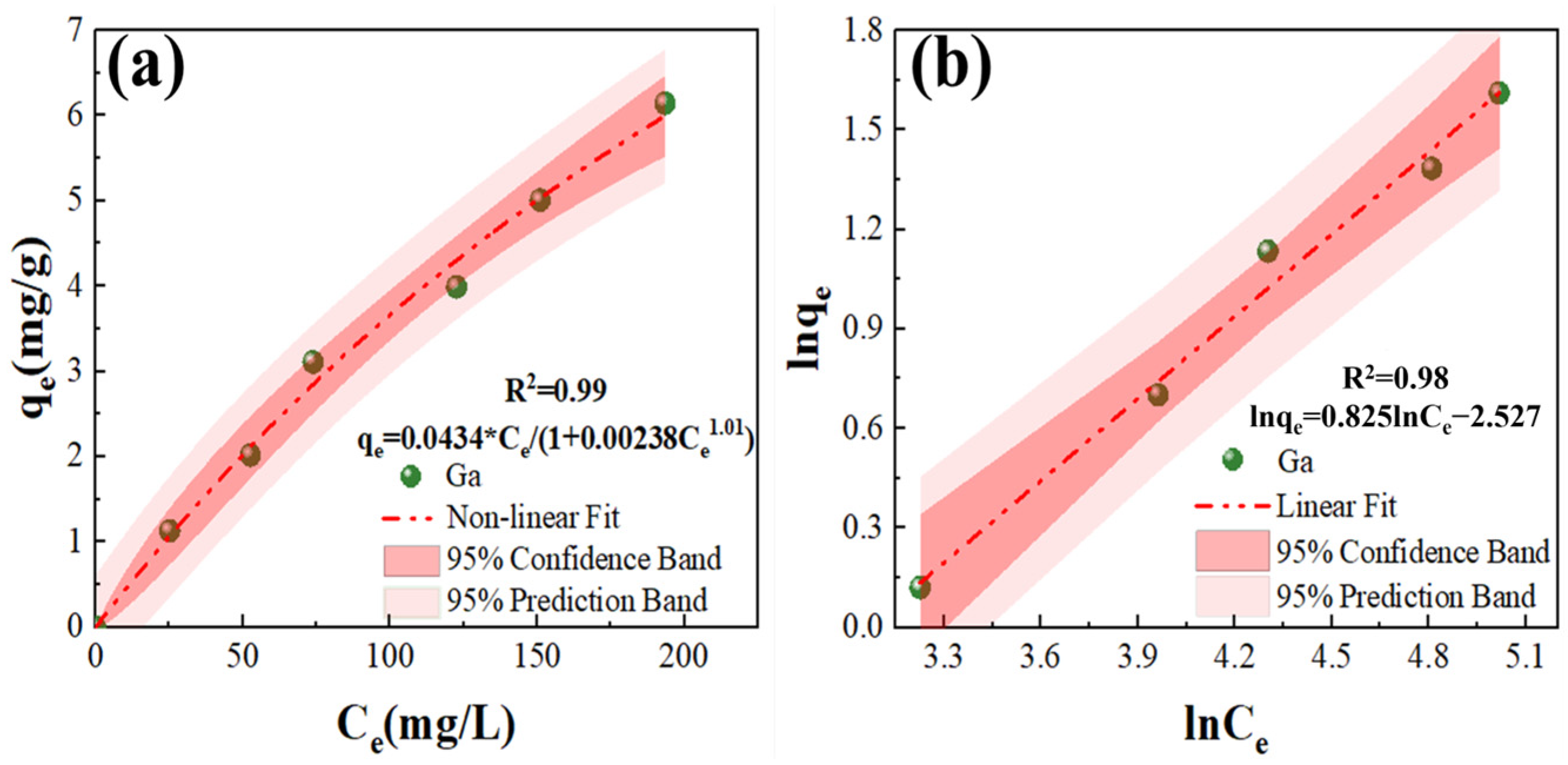
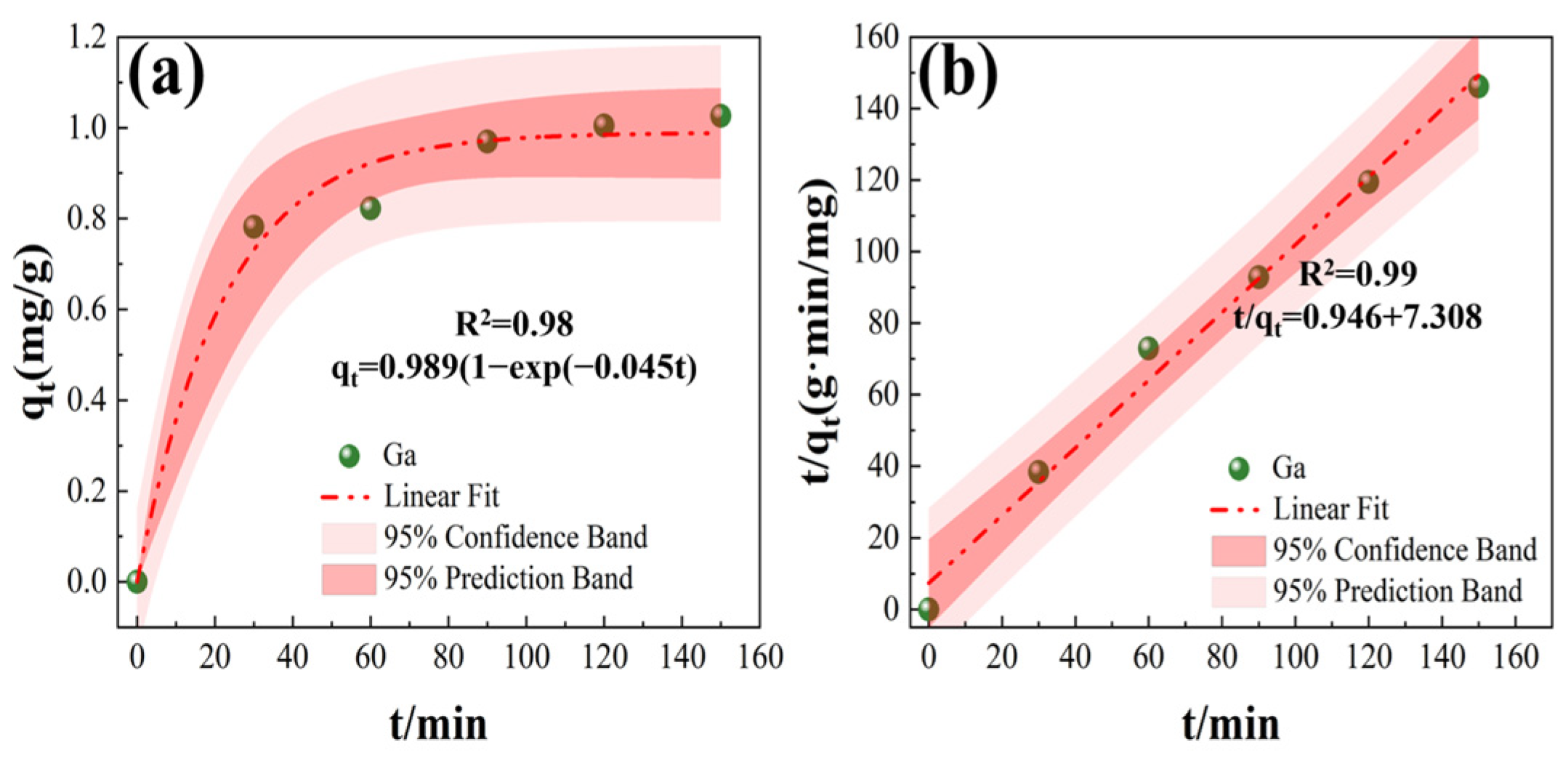

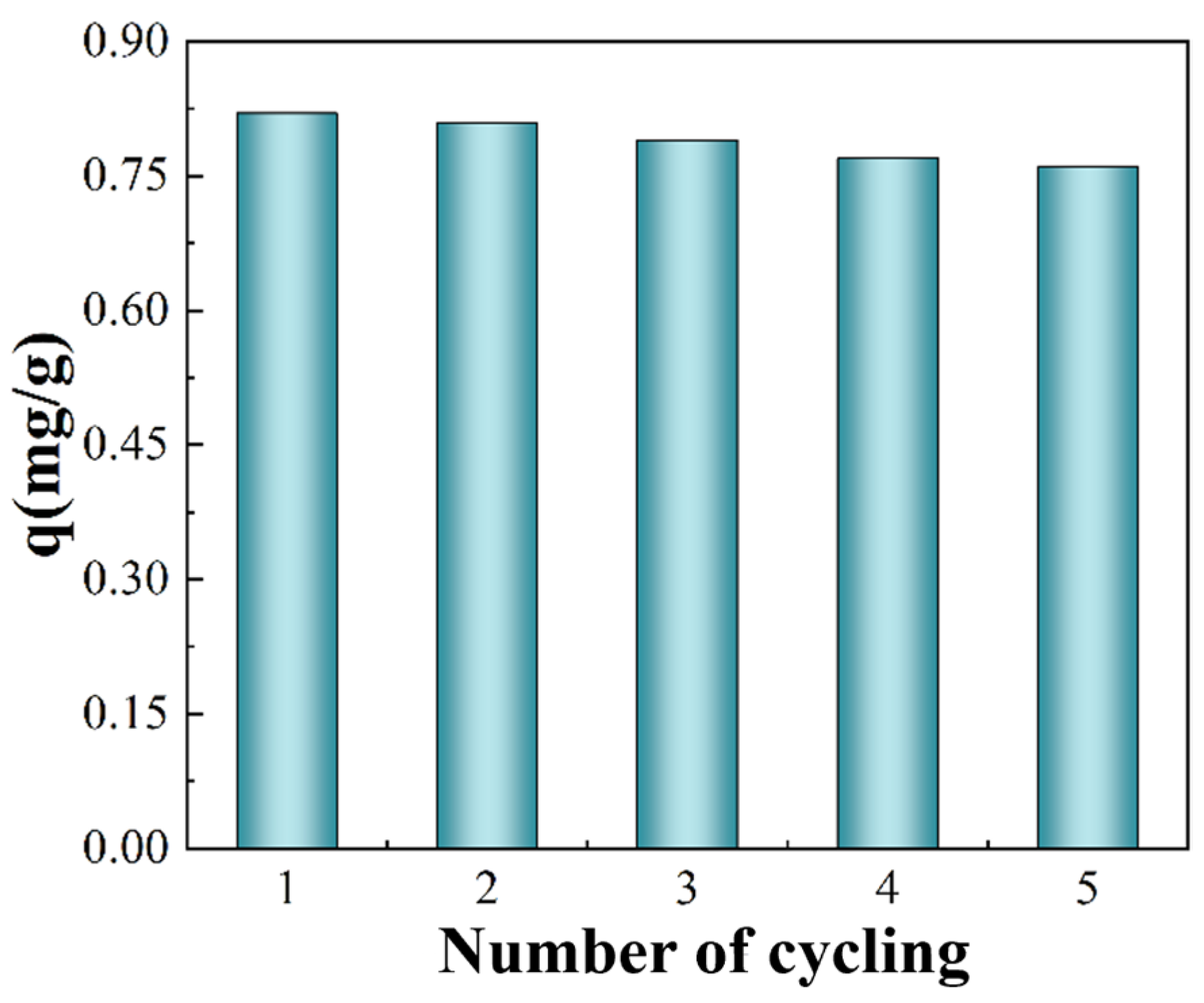
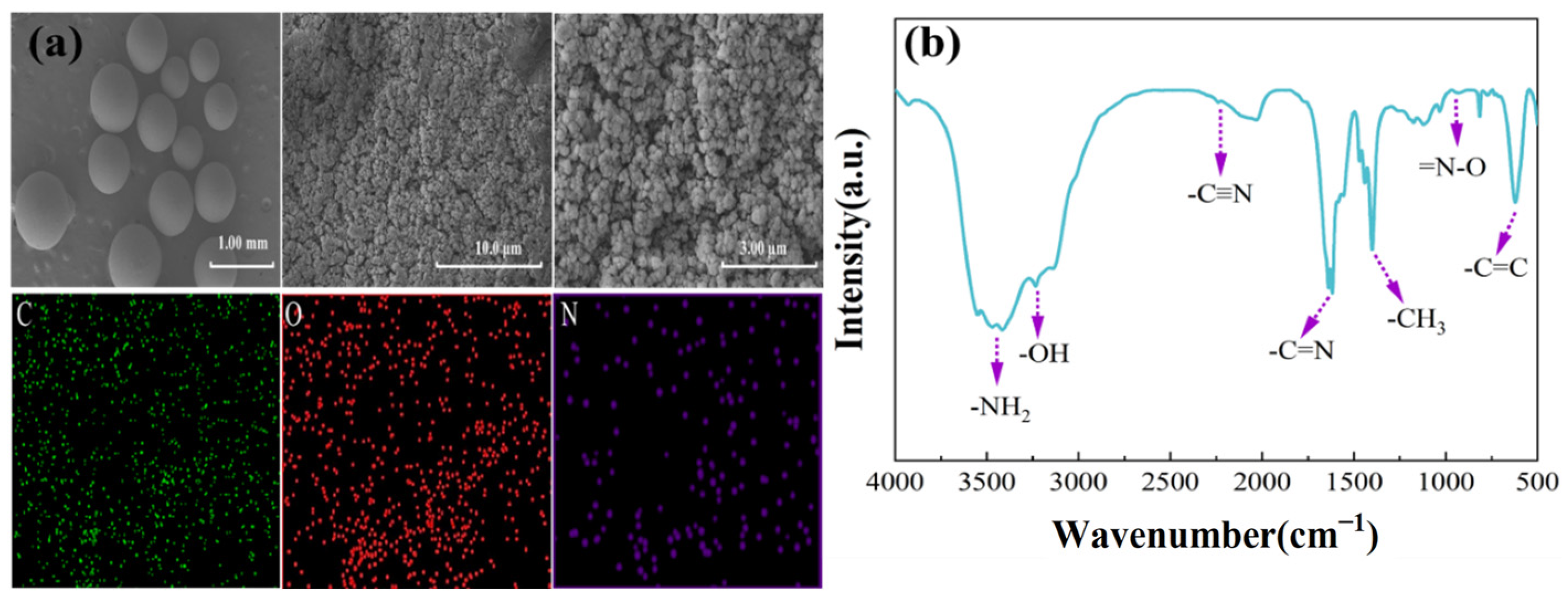
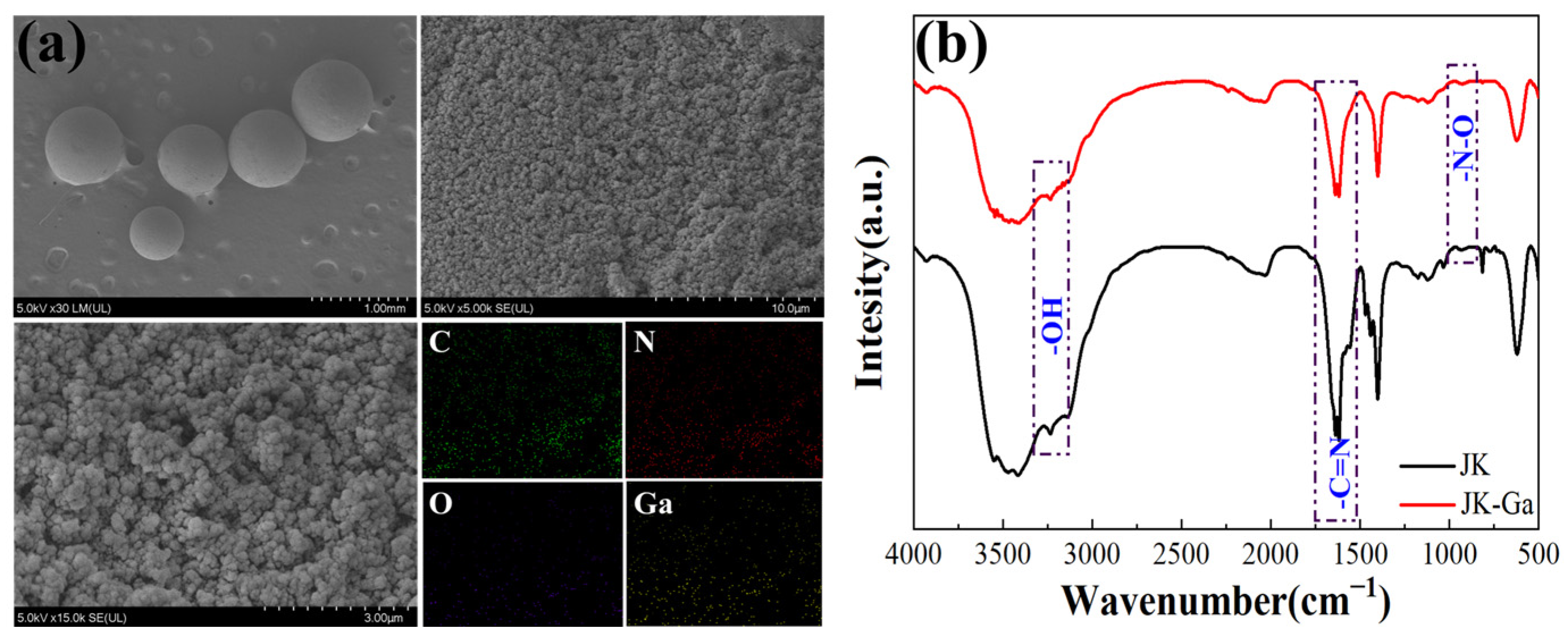
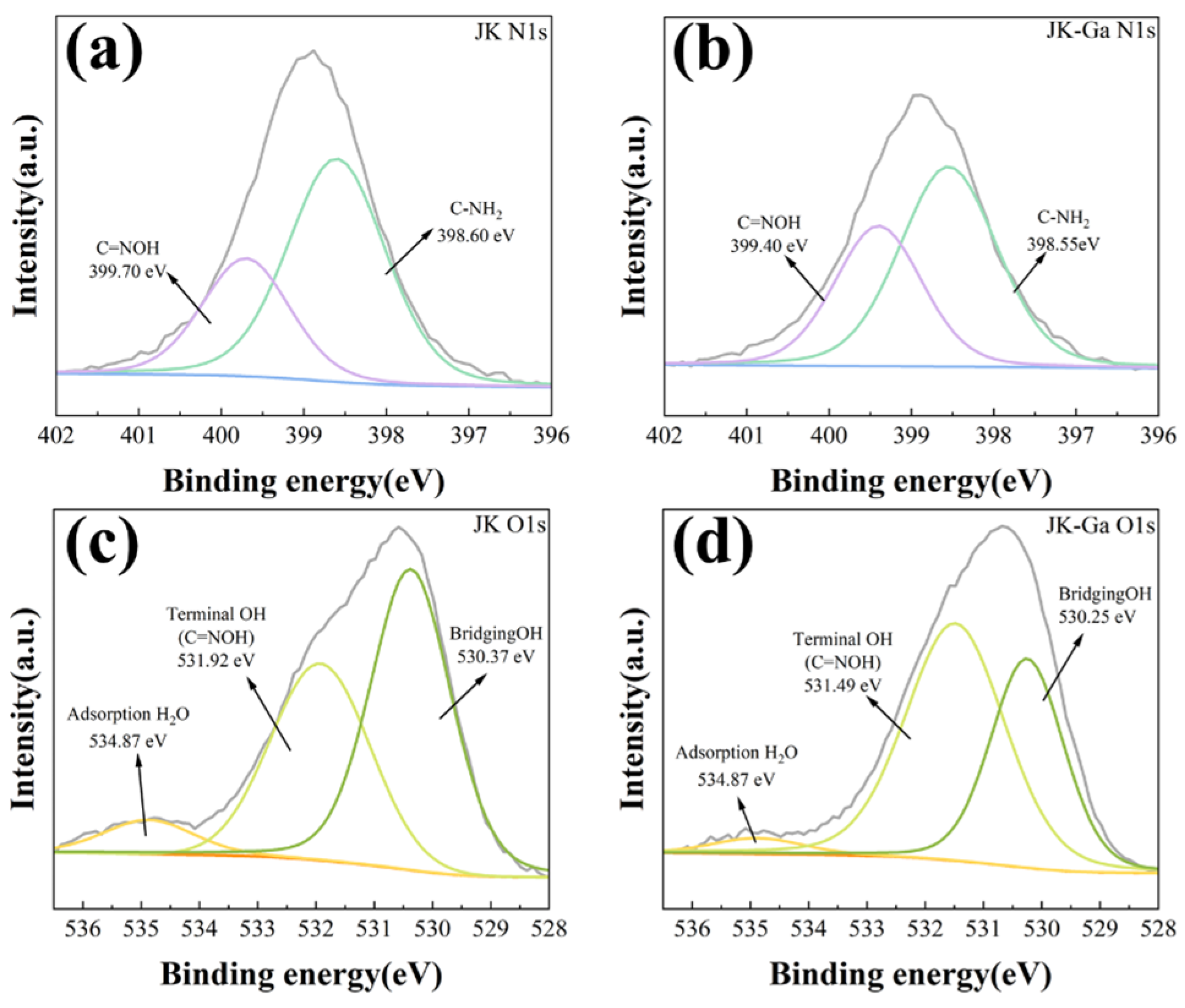
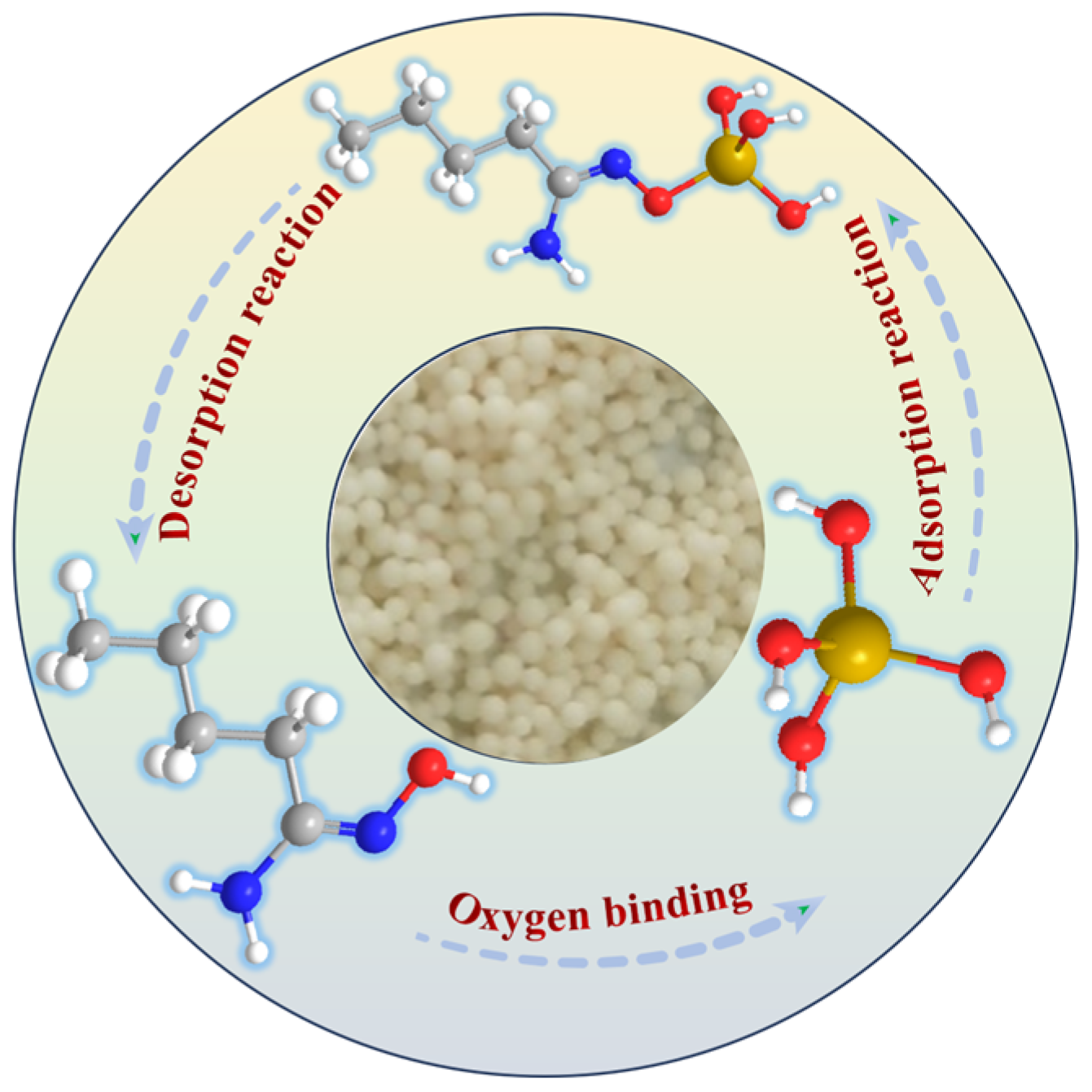
| Solution Components | Ga (mg/L) | V (mg/L) | Al (g/L) | NaOH (mol/L) |
|---|---|---|---|---|
| Concentration | 200 | 120 | 30 | 3 |
| Adsorbents | Co (mg/L) | pH | q (mg/g) | Ref |
|---|---|---|---|---|
| LSC600 resin | 25 | 13.7 | 3.6 | [33] |
| LSC700 resin | 200 | 14 | 12.3 | [32] |
| JK resin | 200 | 14.48 | 18.25 | This work |
| Materials | Pseudo-First Order Model (mg/g) | k1 (min−1) | Pseudo-Second Order Model (mg/g) | k2 (mg/(g·min)) | Ref |
|---|---|---|---|---|---|
| LSC600 resin | 0.39 | 0.0176 | 0.43 | 0.0507 | [33] |
| JK resin | 0.989 | 0.045 | 1.11 | 0.1212 | This work |
Disclaimer/Publisher’s Note: The statements, opinions and data contained in all publications are solely those of the individual author(s) and contributor(s) and not of MDPI and/or the editor(s). MDPI and/or the editor(s) disclaim responsibility for any injury to people or property resulting from any ideas, methods, instructions or products referred to in the content. |
© 2024 by the authors. Licensee MDPI, Basel, Switzerland. This article is an open access article distributed under the terms and conditions of the Creative Commons Attribution (CC BY) license (https://creativecommons.org/licenses/by/4.0/).
Share and Cite
Qin, Z.; Jin, X.; Yang, Z.; Xin, Y.; Liu, W. The Effective Separation of Gallium, Vanadium, and Aluminum from a Simulated Bayer Solution by Resin Exchange. Materials 2024, 17, 4109. https://doi.org/10.3390/ma17164109
Qin Z, Jin X, Yang Z, Xin Y, Liu W. The Effective Separation of Gallium, Vanadium, and Aluminum from a Simulated Bayer Solution by Resin Exchange. Materials. 2024; 17(16):4109. https://doi.org/10.3390/ma17164109
Chicago/Turabian StyleQin, Zhifeng, Xi Jin, Zhen Yang, Yuntao Xin, and Weizao Liu. 2024. "The Effective Separation of Gallium, Vanadium, and Aluminum from a Simulated Bayer Solution by Resin Exchange" Materials 17, no. 16: 4109. https://doi.org/10.3390/ma17164109





